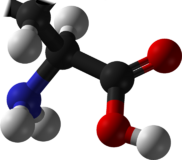Chemistry:Secondary amino acid
In organic chemistry, secondary amino acids are amino acids which do not contain the amino group –NH
2 but is rather a secondary amine (>NH). Secondary amino acids can be classified to cyclic acids, such as proline, and acyclic N-substituted amino acids.[1][2]
In nature, proline, hydroxyproline, pipecolic acid and sarcosine are well-known secondary amino acids. Proline is the only proteinogenic secondary amino acids. Other secondary amino acids are non-proteinogenic amino acids. In protein, hydroxyproline is incorporated into protein by hydroxylation of proline. Pipecolic acid, a heavier analog of proline, is found in efrapeptin. Sarcosine is a N-methylized glycine so its methyl group is used in many biochemical reactions. Azetidine-2-carboxylic acid, which is a smaller homolog of proline in plants.
Properties
Proline and its higher homolog pipecolic acid affect the secondary structure of protein. D-alpha-amino acid - L-alpha-amino acid sequence can induce beta hairpin.[1] It suggested that acyclic secondary amino acids are more flexible than cyclic secondary amino acids in protein by replacement of pipecolic acid by N-methyl-L-alanine in efrapeptin C.[1]
Ninhydrin tests of proline and hydroxyproline give yellow results.
In enzymology, a N-methyl-L-amino-acid oxidase is an oxidase of a subtype of secondary amino acids.
See also
- Imino acid
- Imidic acid
- Secondary amine
References
- ↑ 1.0 1.1 1.2 "Conformational Properties of Secondary Amino Acids: Replacement of Pipecolic Acid by N-Methyl-L-alanine in Efrapeptin C". Chemistry & Biodiversity 10 (5): 942–951. 2013. doi:10.1002/cbdv.201300086. PMID 23681735.
- ↑ V V Ryakhovskii; S V Agafonov; Yu M Kosyrev (1991). "Special features of the synthesis of peptides containing secondary amino acids". Russ. Chem. Rev. 60 (8): 924–933. doi:10.1070/RC1991v060n08ABEH001119. Bibcode: 1991RuCRv..60..924R.
External links
 |


